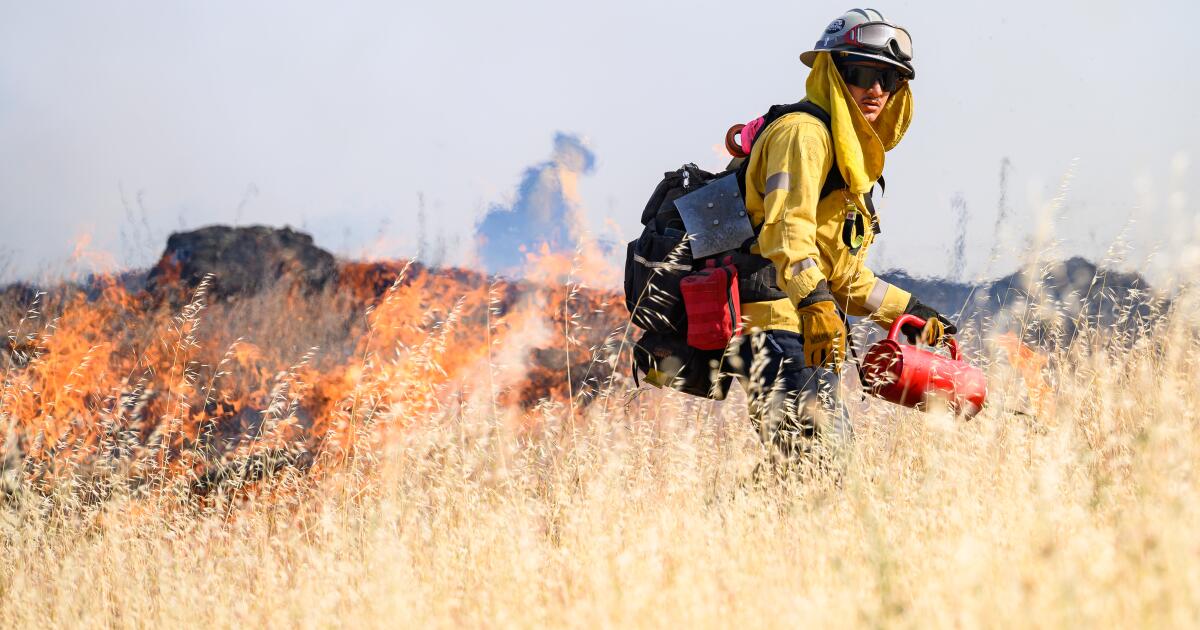At last month’s meeting of the California Wildfire and Forest Resilience Task Force in Redlands, Director Patrick Wright remembered the group’s early days: “Candidly, when I started this job, we got an earful from Southern California.”
Gov. Gavin Newsom created the task force in 2021 and at the time, Southern California’s wildfire experts told Wright that he and other state leaders “didn’t understand Southern California was different. Its vegetation is different. Its fire risk is different.”
It’s true — the coastal chaparral native to much of Southern California is entirely different from the mixed-conifer forests of the Sierra.
More than a century of humans attempting to suppress nearly every fire meant the low-intensity burns that northern forests relied on every 5 to 20 years to promote regeneration no longer came through to clear the understory. As trees and shrubs grew in, they fueled high-intensity fires that decimated both the forest and communities.
Meanwhile in Southern California, as humans settled into the wildlands, they lit more fires. Discarded cigarettes, sparking cars, poorly managed campfires, utility equipment and arsonists lit up hundreds or thousands of acres. Here, the native chaparral is adapted to fire coming every 30 to 130 years. The more frequent fires didn’t allow them to grow, make seeds and reproduce. Instead, what’s grown in places where chaparral used to be are flammable invasive grasses.
But when I first moved to Southern California and started covering the wildfires devastating our communities, I had only heard the northern version of the story.
You’re reading Boiling Point
The L.A. Times climate team gets you up to speed on climate change, energy and the environment. Sign up to get it in your inbox every week.
By continuing, you agree to our Terms of Service and our Privacy Policy.
The fire problem in Northern California is more widely understood. “Smokey the Bear, only you can prevent forest fires — everybody kind of knows, intuitively, what a forest fire is,” said Michael O’Connell, president and chief executive of the Irvine Ranch Conservancy — and one of the people who (respectfully) gave Wright an earful.
Meanwhile, ember-driven fires in Southern California are “like someone lobbing grenades from five miles away,” he said.
Experts in both NorCal and SoCal agree on how we ought to protect ourselves once a ferocious fire breaks out: Across the board, we need to harden our homes, create defensible space and ensure we’re ready to evacuate. But how to prevent devastating fires differs.
The forest thinning and careful reintroduction of intentional “good” fire in the Sierra don’t exactly translate to the Santa Monica Mountains, for example.
The problem here in the south is more vexing: How do we reduce the number of fires we spark?
One way is with groups like Orange County Fire Watch and Arson Watch in Topanga and Malibu, which go out on days when the wind is high and try to spot fires before they start. A new effort, celebrated by the task force, to reduce ignitions along SoCal roadways by clearing flammable vegetation is also underway.
But, while NorCal has a plethora of studies affirming the effectiveness of forest thinning and burning, there is little research yet on SoCal’s proposed solutions.
“We really do, now, understand what the problem is that we’re trying to deal with,” O’Connell said. “How do you get that done? That’s more complicated.”
And the vast majority of state funding is still geared toward northern fuel management solutions — not keeping fires from sparking. (The task force also still measures progress in acres treated, a largely meaningless metric for Southern California’s chaparral.)
Yet, O’Connell is hopeful. At the task force’s first meeting in SoCal — where Wright got an earful — leaders didn’t yet have a grasp of SoCal’s wildfire problem. Now, they’re letting SoCal’s land managers and researchers lead the way.
“If it weren’t for the task force, I think we would be in big trouble, frankly,” O’Connell said. The task force leaders “have not only understood [the problem] but have accepted it and run with that.”
Here’s the latest on wildfires
Federal firefighters are in their third week without pay, as the U.S government shutdown drags on. According to the U.S. Forest Service — the largest federal firefighting force in the country — fire response personnel will continue to work through the shutdown, although prevention work, including prescribed burns and forest thinning, will be limited.
In California, Gov. Gavin Newsom vetoed a bill that would increase the salaries of Cal Fire firefighters to more closely match those of local fire departments. Meanwhile, efforts championed by the state to build a series of fuel breaks in the Santa Monica Mountains are underway. Some ecologists worry about the damage the fast-moving project could do to the environment; others say the state is not moving fast enough.
Last week, federal prosecutors announced the arrest of a suspect they believed intentionally started the Palisades fire on Jan. 1. The announcement has led to calls for both the Los Angeles Fire Department, responsible for putting out the Jan. 1 fire, and California State Parks, whose land the fire started on, to be held accountable.
And the latest on climate
A turning point and a tipping point: Global energy production turned a corner in the first half of the year, with renewables such as solar and wind generating more electricity than coal for the first time. And, the Earth is reaching its first climate change tipping point: Warm water coral reefs can no longer survive, according to a report published by 160 scientists.
With the 2025 state legislative session wrapped up, some important climate bills are now law. One law extends California’s cap-and-trade program — which limits how much greenhouse gas polluters can emit and enables them to trade emission allowances at auction — from 2030 to 2045. Newsom also signed a bill to make oil drilling in Kern County easier while making offshore drilling more difficult and another to push local governments to increase electrification efforts.
Newsom vetoed a bill that would have required data centers to report how much water they use. He was “reluctant to impose rigid reporting requirements” on the centers, he wrote in a message explaining his veto, noting that “California is well positioned to support the development of this critically important digital infrastructure.”
This is the latest edition of Boiling Point, a newsletter about climate change and the environment in the American West. Sign up here to get it in your inbox. And listen to our Boiling Point podcast here.
For more wildfire news, follow @nohaggerty on X and @nohaggerty.bsky.social on Bluesky.









